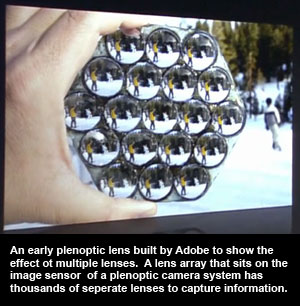![]() all things design
all things design
June 14, 2011
Plenoptic Lenses
Have you ever wanted to take a picture and had only seconds to get it right before the shot was lost? You grabbed your camera, brought it up and clicked the shutter. Did you get it? Sort of. You got the shot, but, it’s out of focus. You can make out what the image is, however, it lacks the clarity a good photograph must have. Well take heart, the future holds a solution to this type of problem and it’s in the form of an emerging lens system called plenoptics.
Plenoptics is the product of more than a decade of research from Adobe in collaboration with institutions such as Stanford and Indiana Universities. Plenoptic lens systems capture multiple focal settings on one take of a picture, giving users the ability to refocus within the depth of field after the fact. To do this, the system uses an array of micro-lenses on top of the image sensor splitting the captured image into thousands of separate image fragments. Each fragment captures separate paths of light and then is decoded by computer software to  produce the final image. Refocusing the image is as simple as moving an onscreen slider to adjust the depth of field. The system also has the ability to view two slightly different angles of the image to create stereoscopic 3-D stills and video.
produce the final image. Refocusing the image is as simple as moving an onscreen slider to adjust the depth of field. The system also has the ability to view two slightly different angles of the image to create stereoscopic 3-D stills and video.
This technology comes with a price tag. The only mass produced plenoptic camera available today is the German-made Raytrix R11 and they cost $30,000. For that hefty sum of money you get a final image of 3 megapixels (the small point and shoot cameras most people tote around are in the 12 megapixel range) and video runs at a scant six frames per second. Not much for your money today, however, this technology is here and growing and Adobe is betting that it will make its way into mainstream cameras sooner than later; they are hard at work on a version of Photoshop that will edit plenoptic images.
For more information on plenoptic lens systems check out the links on the right.
‘til next time, take care.
Bob

